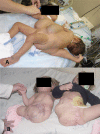Conjoined twins: twenty years' experience at a reference center in Brazil
- PMID: 23644858
- PMCID: PMC3611880
- DOI: 10.6061/clinics/2013(03)oa14
Conjoined twins: twenty years' experience at a reference center in Brazil
Abstract
Objective: This study reports on the experience of one hospital regarding the surgical aspects, anatomic investigation and outcomes of the management of 21 conjoined twin pairs over the past 20 years.
Methods: All cases of conjoined twins who were treated during this period were reviewed. A careful imaging evaluation was performed to detail the abdominal anatomy (particularly the liver), inferior vena cava, spleen and pancreas, either to identify the number of organs or to evaluate the degree of organ sharing.
Results: There were eight sets of ischiopagus twins, seven sets of thoracopagus twins, three sets of omphalopagus twins, two sets of thoraco-omphalo-ischiopagus twins and one set of craniopagus twins. Nine pairs of conjoined twins could not be separated due to the complexity of the organs (mainly the liver and heart) that were shared by both twins; these pairs included one set of ischiopagus twins, six sets of thoracopagus twins and one set of thoraco-omphalo-ischiopagus twins. Twelve sets were separated, including seven sets of ischiopagus twins, three sets of omphalopagus twins, one set of thoracopagus twins and one set of craniopagus conjoined twins. The abdominal wall was closed in the majority of patients with the use of mesh instead of the earlier method of using tissue expanders. The surgical survival rate was 66.7%, and one pair of twins who did not undergo separation is currently alive.
Conclusion: A detailed anatomic study of the twins and surgical planning must precede separation. A well-prepared pediatric surgery team is sufficient to surgically manage conjoined twins.
Conflict of interest statement
No potential conflict of interest was reported.
Figures



Similar articles
-
Conjoined twins in the Philippines: experience of a single institution.Pediatr Surg Int. 2009 Sep;25(9):775-80. doi: 10.1007/s00383-009-2426-7. Pediatr Surg Int. 2009. PMID: 19697051
-
Separation of Thoraco-Omphalo-Ischiopagus Conjoined Twins: Surgical Planning, Management, and Outcomes.Plast Reconstr Surg. 2016 Nov;138(5):1064-1072. doi: 10.1097/PRS.0000000000002660. Plast Reconstr Surg. 2016. PMID: 27783004
-
Conjoined twins--the Cape Town experience.Pediatr Surg Int. 1997 Apr;12(4):234-48. doi: 10.1007/BF01372142. Pediatr Surg Int. 1997. PMID: 9099638
-
Ischiopagus and pygopagus conjoined twins: neurosurgical considerations.Childs Nerv Syst. 2004 Aug;20(8-9):640-51. doi: 10.1007/s00381-004-0987-2. Epub 2004 Jul 27. Childs Nerv Syst. 2004. PMID: 15278384 Review.
-
Imaging in the preoperative assessment of conjoined twins.Radiographics. 2001 Sep-Oct;21(5):1187-208. doi: 10.1148/radiographics.21.5.g01se011187. Radiographics. 2001. PMID: 11553825 Review.
Cited by
-
The Outcomes of Surgical Separation in Thoracopagus Twins with Conjoined Hearts: An Analysis of the Literature.Pediatr Cardiol. 2021 Apr;42(4):875-882. doi: 10.1007/s00246-021-02555-8. Epub 2021 Apr 15. Pediatr Cardiol. 2021. PMID: 33856497
-
The Multidisciplinary Perioperative Management of Conjoined Twin Separation Surgery During the Pandemic.J Multidiscip Healthc. 2022 Nov 18;15:2669-2678. doi: 10.2147/JMDH.S390419. eCollection 2022. J Multidiscip Healthc. 2022. PMID: 36425878 Free PMC article.
-
Omphalopagus conjoined twins separation during coronavirus disease-19 pandemic era: A case report.Int J Surg Case Rep. 2021 Jul;84:106150. doi: 10.1016/j.ijscr.2021.106150. Epub 2021 Jun 29. Int J Surg Case Rep. 2021. PMID: 34221850 Free PMC article.
-
Conjoined twin at abdomen: twin A anencephaly and face presentation with twin B cephalic presentation: a case report and review of the literature.J Med Case Rep. 2024 Dec 6;18(1):597. doi: 10.1186/s13256-024-04894-5. J Med Case Rep. 2024. PMID: 39639390 Free PMC article. Review.
-
Thoraco-Omphalopagus Twins: A Case Report.Cureus. 2025 Jul 6;17(7):e87365. doi: 10.7759/cureus.87365. eCollection 2025 Jul. Cureus. 2025. PMID: 40765601 Free PMC article.
References
-
- Jackson OA, Low DW, Larossa D. Conjoined twin separation: lessons learned. PlastReconstr Surg. 2012;129(4):956–63. - PubMed
-
- Rode H, Fieggen AG, Brown RA, Cywes S, Davies MR, Hewitson JP, et al. Four decades of conjoined twins at Red Cross Children's Hospital – lessons learned. S Afr Med J. 2006;96(9 Pt 2):931–40. - PubMed
-
- Spencer R. Anatomic description of conjoined twins: a plea for standardized terminology. J Pediatr Surg. 1996;31(7):941–4. - PubMed
-
- Berezowski AT, Duarte G, Rodrigues R, de Carvalho Cavalli R, dos Santos R de O, de Andrade Vicente YA, et al. Conjoined twins: an experience of a tertiary hospital in Southeast Brazil. Rev Bras Ginecol Obstet. 2010;32(2):61–5. - PubMed
Publication types
MeSH terms
LinkOut - more resources
Full Text Sources
Other Literature Sources
Miscellaneous

